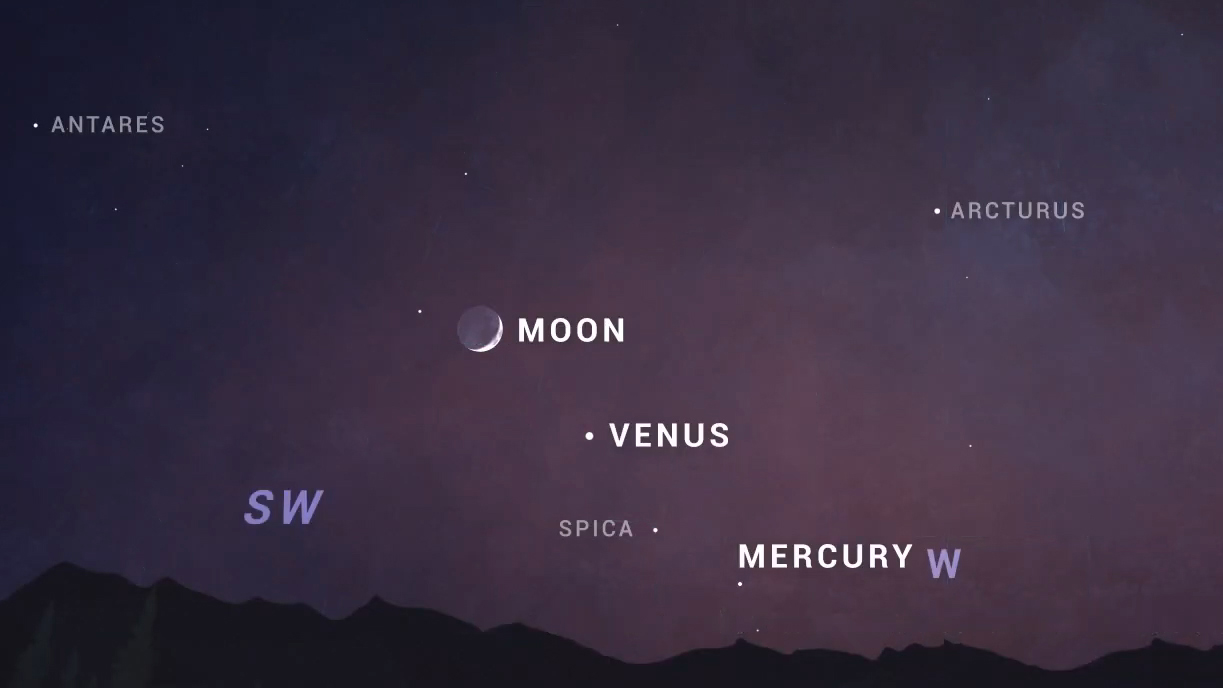
Thursday evening (Sept. 9) will bring a lovely celestial display involving the two brightest objects in the nighttime sky.
The planet Venus, which has been languishing low in the dusk all summer, at last manages to stay above the west-southwest horizon as late as the end of evening twilight. About 45 minutes after sunset on Thursday, look toward the west-southwest horizon to see Venus hovering near to a waxing crescent moon; an eye-catching tableau in spite of the pair's low altitude.
Venus will likely catch your eye first; it will be shining less than 10 degrees above the horizon — less than the width of your clenched fist held at arm's length. Make sure that you have a clear and unobstructed view — no trees or buildings — toward the west-southwest. Now look off to the upper right of Venus and you'll also see the slender sliver of a waxing crescent moon. This eye-catching duo will quickly descend as the sky darkens, finally setting about 90 minutes after sunset beyond the west-southwest horizon.
Related: The brightest planets in September's night sky: How to see them (and when)
A striking pair
These two celestial objects will certainly attract immediate attention because of their great brightness. Venus shines at magnitude -4.1, which makes it eleven times brighter than Sirius, the brightest star in Earth's night sky.
The moon will be three days past new phase and about 11% illuminated. Look also for the beautiful phenomenon known as "Earthshine" — sunlight reflected by the Earth, directed toward the moon and dimly illuminating its dark portion with a faint grey-blue glow. That effect will impart an almost three-dimensional appearance to the moon and will enhance the overall scene.
Venus is currently 97 million miles (156 million kilometers) from the Earth, while the moon is only about 228,900 miles (368,200 km) away, so as a result it appears to move much more rapidly against the background stars than Venus. As a consequence of this rapid movement, when the sun sets on the following (Friday) evening, the configuration between Venus and the moon will have radically changed. In fact, the moon — whose illuminated sliver will have noticeably widened to 19% — will now be positioned far to the east of Venus.
Get the Space.com Newsletter
Breaking space news, the latest updates on rocket launches, skywatching events and more!

During the daytime, too!
And the moon's proximity relative to Venus will also give you a chance to try and glimpse Venus during the daytime. If your sky is mostly clear with little or no haze, check your south-southwest sky during the late afternoon hours of Thursday — say around 4:30 p.m. — and try to locate the moon, which will appear more than one-third up from the horizon to the overhead point (called the zenith).
If you find the moon, Venus will be situated just about five degrees to its lower left. Try using binoculars first and then your bare (unaided) eyes.
Don't forget Spica!
And while you're admiring Venus and the moon in Thursday's twilight sky, don't overlook bluish star Spica, one of the brightest stars in the sky, in the constellation Virgo. Spica, Venus and the moon will form a nearly equilateral triangle, measuring about 4 degrees all around.
Spica will appear directly below Venus and the moon. The bright twilight backdrop might make Spica a bit difficult to see, so again I would suggest using binoculars initially to pick it up, then try for it with just your eyes alone.
And if clouds block your view of Sunday's celestial get together, another, much closer pairing-off — this time with the bright ruddy star Antares twinkling off to one side — will occur a month from now, on Oct. 8.
Joe Rao serves as an instructor and guest lecturer at New York's Hayden Planetarium. He writes about astronomy for Natural History magazine, the Farmers' Almanac and other publications. Follow us on Twitter @Spacedotcom and on Facebook.
Join our Space Forums to keep talking space on the latest missions, night sky and more! And if you have a news tip, correction or comment, let us know at: community@space.com.

Joe Rao is Space.com's skywatching columnist, as well as a veteran meteorologist and eclipse chaser who also serves as an instructor and guest lecturer at New York's Hayden Planetarium. He writes about astronomy for Natural History magazine, Sky & Telescope and other publications. Joe is an 8-time Emmy-nominated meteorologist who served the Putnam Valley region of New York for over 21 years. You can find him on Twitter and YouTube tracking lunar and solar eclipses, meteor showers and more. To find out Joe's latest project, visit him on Twitter.









